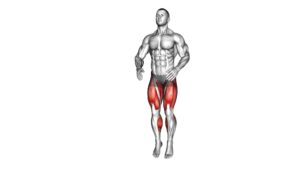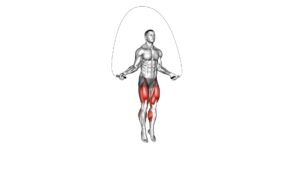Double Jump Squat – Video Exercise Guide & Tips

Are you looking to level up your leg workout? Look no further than the double jump squat!
Watch This Exercise Video
In this video exercise guide, we'll show you the proper form and technique for this intense move.
Whether you're a beginner or a seasoned fitness enthusiast, we've got modifications to suit your fitness level.
Avoid common mistakes and learn how to increase intensity for maximum results.
Get ready to take your squats to new heights with our double jump squat tips!
Key Takeaways
- Double jump squats enhance explosive power development.
- Double jump squats engage multiple muscle groups simultaneously.
- Double jump squats improve vertical jump height.
- Double jump squats strengthen quadriceps, hamstrings, glutes, and calves.
Benefits of Double Jump Squats
Double jump squats offer numerous benefits for your lower body strength and explosive power. Incorporating plyometric training into your workout routine can significantly enhance your explosive power development. By performing double jump squats, you engage multiple muscle groups simultaneously, including your quadriceps, hamstrings, glutes, and calves. This exercise is particularly effective for improving vertical jump height and overall lower body strength.
The explosive nature of double jump squats requires you to exert maximum force in a short amount of time. This helps to improve your fast-twitch muscle fibers, which are responsible for generating explosive power. Additionally, the plyometric nature of this exercise helps to improve the stretch-shortening cycle of your muscles, allowing them to generate more force during explosive movements.
When performing double jump squats, it's crucial to maintain proper form to maximize the benefits and minimize the risk of injury. Start by standing with your feet shoulder-width apart and lower into a squat position. From here, explosively jump as high as you can while swinging your arms. As you land, immediately go back into a squat position and repeat the jump. Aim for a smooth and controlled movement throughout the exercise.
Incorporating double jump squats into your plyometric training routine can greatly enhance your explosive power development and lower body strength. Regular practice of this exercise will help you improve your athletic performance, whether you're involved in sports that require jumping or simply looking to increase your overall power output.
Proper Form and Technique
To ensure maximum benefits and minimize the risk of injury, focus on maintaining proper form and technique while performing double jump squats. Proper alignment is crucial during this exercise. Start by standing with your feet hip-width apart and your toes pointing slightly outward. Throughout the movement, keep your knees in line with your toes to prevent any unnecessary strain on your joints. Engage your core and maintain a neutral spine, avoiding any excessive rounding or arching.
One common mistake to watch out for is allowing your knees to collapse inward as you jump. This can put excessive stress on your knee joints and increase the risk of injury. To avoid this, consciously push your knees outwards as you jump, keeping them in line with your toes.
Another important aspect of proper form is the depth of your squat. While it's essential to lower your hips until your thighs are parallel to the ground, going too low can strain your knees and lower back. Find a comfortable range of motion where you can maintain proper alignment and control throughout the exercise.
Remember to land softly and quietly, absorbing the impact through your muscles rather than your joints. This won't only protect your joints but also improve your overall athleticism and reduce the risk of injury.
Modifications for Different Fitness Levels
If you regularly exercise, you can easily modify the double jump squat to suit your fitness level. Before incorporating double jump squats into your workout routine, it's important to take some safety precautions.
Make sure you have a clear space to perform the exercise and wear proper athletic shoes to provide stability and support. If you have any pre-existing knee or joint issues, it's recommended to consult with a healthcare professional before attempting this exercise.
To modify the double jump squat for beginners or those with lower fitness levels, you can start by performing regular bodyweight squats instead. Focus on maintaining proper form and gradually increase your depth and speed as you become more comfortable. As you progress, you can then add a small jump at the end of each squat, gradually increasing the height and intensity of the jump over time.
For more advanced individuals, you can incorporate weighted jump squats into your routine by holding dumbbells or wearing a weighted vest. This will increase the resistance and challenge your muscles even further.
In the next section, we'll discuss common mistakes to avoid when performing double jump squats to ensure you get the most out of this exercise and prevent any potential injuries.
Common Mistakes to Avoid
To maximize the effectiveness of the double jump squat and prevent potential injuries, it's important to be aware of common mistakes to avoid. By understanding these mistakes, you can perform the exercise correctly and safely.
One common mistake isn't maintaining proper form throughout the movement. This can lead to unnecessary strain on the knees and lower back. To avoid this, make sure to keep your knees aligned with your toes and your back straight throughout the exercise.
Another mistake isn't using enough power in the jump. This can reduce the effectiveness of the exercise and limit the benefits for your lower body. To avoid this, focus on exploding upwards with maximum force during the jump.
Lastly, rushing through the exercise is a common mistake. By performing the double jump squat too quickly, you increase the risk of injury and decrease the effectiveness of the exercise. Take your time and ensure that each rep is performed with control and precision.
Tips for Increasing Intensity and Progression
To increase the intensity and progression of the double jump squat, incorporate weighted resistance into your workouts. By adding dumbbells, kettlebells, or a weighted vest, you challenge your muscles even more, making the exercise more difficult and effective. Start with a weight that's challenging but manageable, and gradually increase it as you get stronger and comfortable with the movement.
Another way to increase the difficulty of the double jump squat is by incorporating advanced variations. One option is to perform the exercise on an unstable surface, such as a Bosu ball or a balance board. This forces your muscles to work harder to stabilize your body, enhancing the intensity of the exercise.
Additionally, you can try performing the double jump squat with a medicine ball. Hold the ball in front of your chest as you perform the squat and explode into the jump. This not only adds resistance but also requires more coordination and balance.
Remember to always prioritize proper form and technique when increasing the intensity and progression of the double jump squat. Focus on maintaining a strong core, keeping your knees aligned with your toes, and landing softly to protect your joints. With consistency and determination, you can continue to challenge yourself and reap the benefits of this powerful exercise.
Frequently Asked Questions
How Many Calories Can You Burn by Doing Double Jump Squats?
Incorporating double jump squats into your HIIT routine can have numerous benefits. Not only does it help to increase your cardiovascular endurance, but it also targets multiple muscle groups, including your legs, glutes, and core.
To maximize calorie burn during double jump squats, it's important to perform them correctly. Start by standing with your feet shoulder-width apart, then lower into a squat position. As you explode upwards, jump as high as you can while bringing your knees towards your chest. Repeat for a challenging and effective workout.
Can Double Jump Squats Help Improve Vertical Jump Height?
Double jump squats can be beneficial for improving your vertical jump height. By incorporating explosive jumps into your squatting movement, you engage the muscles in your legs and core, which are crucial for jumping power.
To perform double jump squats properly, start in a squat position and explode upwards, jumping as high as you can. Land softly, immediately going into the next jump.
Remember to maintain proper form throughout the exercise to maximize its benefits.
Are Double Jump Squats Safe for People With Knee or Back Injuries?
Double jump squats can be a great exercise for improving vertical jump height. However, they may not be safe for people with knee or back injuries. If you have these injuries, it's important to prioritize safety and avoid exercises that could worsen your condition.
Instead, consider safe modifications like single-leg squats or step-ups. These exercises can still target your leg muscles without putting excessive stress on your knees or back.
Always consult with a healthcare professional before starting any new exercise routine.
How Often Should Double Jump Squats Be Incorporated Into a Workout Routine?
To maximize the benefits of incorporating double jump squats into your HIIT workout routine, it's important to find the right balance.
Start by doing them two to three times a week and gradually increase the frequency as you get stronger. Remember to listen to your body and adjust accordingly.
To progress and modify, try adding weights or increasing the height of your jumps. For beginners, start with regular bodyweight squats and gradually work your way up.
Can Double Jump Squats Be Done Without Any Equipment?
Yes, you can definitely do double jump squats without any equipment.
Double jump squats are a great way to challenge your lower body and improve your explosive power.
Without any equipment, you can still perform variations of double jump squats, such as adding a tuck jump or a knee tuck at the top of the movement.
These exercises can help strengthen your legs and increase your overall athletic performance.
Conclusion
In conclusion, double jump squats are a beneficial exercise for improving lower body strength and power. By following proper form and technique, individuals can avoid common mistakes and maximize the benefits of this exercise.
Modifications can be made to accommodate different fitness levels, and tips for increasing intensity and progression can help individuals continue to challenge themselves.
Incorporating double jump squats into a fitness routine can lead to improved overall strength and athletic performance.

Author
Years ago, the spark of my life’s passion ignited in my mind the moment I stepped into the local gym for the first time. The inaugural bead of perspiration, the initial endeavor, the very first surge of endorphins, and a sense of pride that washed over me post-workout marked the beginning of my deep-seated interest in strength sports, fitness, and sports nutrition. This very curiosity blossomed rapidly into a profound fascination, propelling me to earn a Master’s degree in Physical Education from the Academy of Physical Education in Krakow, followed by a Sports Manager diploma from the Jagiellonian University. My journey of growth led me to gain more specialized qualifications, such as being a certified personal trainer with a focus on sports dietetics, a lifeguard, and an instructor for wellness and corrective gymnastics. Theoretical knowledge paired seamlessly with practical experience, reinforcing my belief that the transformation of individuals under my guidance was also a reflection of my personal growth. This belief holds true even today. Each day, I strive to push the boundaries and explore new realms. These realms gently elevate me to greater heights. The unique combination of passion for my field and the continuous quest for growth fuels my drive to break new ground.







